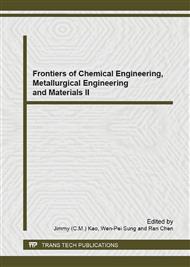p.85
p.90
p.94
p.99
p.103
p.108
p.113
p.118
p.122
Effect of Cu2+ on Ascorbic Acid - Methionine Pattern is Formed by the Reaction of Aroma Compounds
Abstract:
Using solid phase microextraction - Gas Chromatography - mass spectrometry (SPME-GC-MS) technique to acid and methionine bad blood (ASA-Met) analysis of the reaction products, the influence of Cu2+ on the model reaction flavor compounds form effect. 27 flavour compounds thiophene, furan, pyrazine, sulfur and other compounds, were identified, including sulfur compounds, such as aliphatic cyclic sulfides, sulfide, thiophene, pyrazine as main components. Cu2+ was added to the reaction mode, on the one hand, sulfur-containing compounds yield increased significantly; on the other hand, increasing the thiophene, pyrazine compound types, yield increase.
Info:
Periodical:
Pages:
103-107
Citation:
Online since:
September 2013
Authors:
Keywords:
Price:
Сopyright:
© 2013 Trans Tech Publications Ltd. All Rights Reserved
Share:
Citation:


